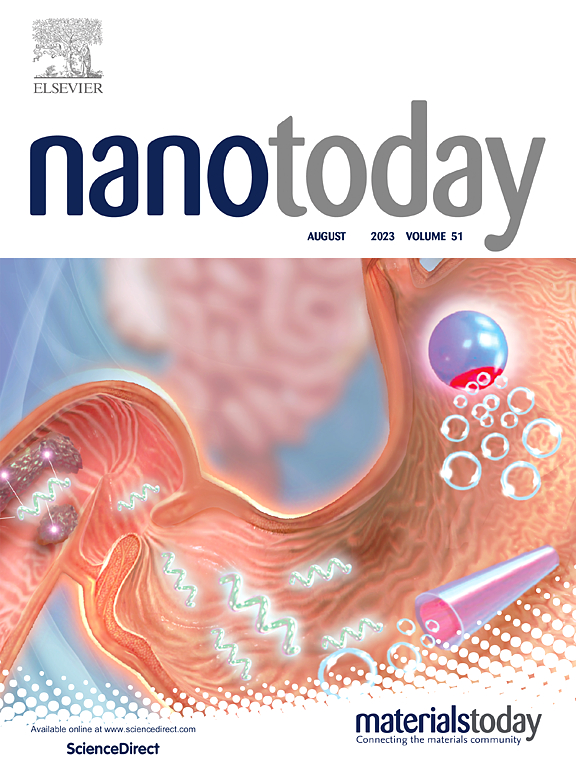In situ nanometer-resolution strain and orientation mapping for gas-solid reactions via precession-assisted four-dimensional scanning transmission electron microscopy
IF 10.9
1区 材料科学
Q1 CHEMISTRY, MULTIDISCIPLINARY
引用次数: 0
Abstract
Chemomechanical interactions in gas or liquid environments are crucial for the functionality and longevity of various materials used in sustainable energy technologies, such as rechargeable batteries, water-splitting catalysts, and next-generation nuclear reactors. A comprehensive understanding of nanoscale strain evolution involved in these processes can advance our knowledge of underlying mechanisms and facilitate material design improvements. However, traditional microscopy workflows face challenges due to trade-offs between field of view (FOV), spatial resolution, temporal resolution, and electron beam damage, particularly in gas or liquid environments. Here, we demonstrate in situ nanometer-resolution strain and orientation mapping in a temperature-controlled gas environment with a large FOV. This is achieved by integrating a microelectromechanical system (MEMS)-based closed-cell TEM holder, precession-assisted four-dimensional scanning transmission electron microscopy (4D-STEM), and a direct electron detector (DED). Using the strain evolution during zirconium initial oxidation as a case study, we first outline critical strategies for focused ion beam (FIB) gas-cell sample preparation and gas-phase TEM workflows to enhance experimental success. We then show that integrating DED with precession electron diffraction (PED) and optimizing gas pressure substantially improve the quantity and quality of the detected Bragg peaks in nano-beam electron diffraction (NBED) patterns, enabling more precise strain and orientation measurements. Furthermore, we introduce a practical protocol to pause the reactions, allowing sufficient time for 4D-STEM data collection while ensuring the temporal resolution needed to resolve material dynamics. Our methodology and workflow provide a robust framework for quantitative analysis of chemomechanical evolutions in materials exposed to gas or liquid environments, paving the way for improved material design in energy-related applications.
利用进动辅助四维扫描透射电子显微镜进行气固反应的纳米分辨率应变和取向成像
气体或液体环境中的化学力学相互作用对于可持续能源技术中使用的各种材料的功能和寿命至关重要,例如可充电电池、水分解催化剂和下一代核反应堆。对这些过程中涉及的纳米尺度应变演化的全面理解可以促进我们对潜在机制的了解,并促进材料设计的改进。然而,由于在视场(FOV)、空间分辨率、时间分辨率和电子束损伤之间的权衡,传统的显微镜工作流程面临挑战,特别是在气体或液体环境中。在这里,我们演示了在具有大视场的温控气体环境中原位纳米分辨率应变和取向映射。这是通过集成基于微机电系统(MEMS)的闭孔TEM支架、进动辅助四维扫描透射电子显微镜(4D-STEM)和直接电子探测器(DED)来实现的。以锆初始氧化过程中的应变演化为例,我们首先概述了聚焦离子束(FIB)气电池样品制备和气相TEM工作流程的关键策略,以提高实验成功率。然后,我们发现将DED与进动电子衍射(PED)相结合并优化气体压力大大提高了纳米束电子衍射(NBED)模式中检测到的Bragg峰的数量和质量,从而实现更精确的应变和取向测量。此外,我们引入了一个实用的方案来暂停反应,为4D-STEM数据收集提供足够的时间,同时确保解决材料动力学所需的时间分辨率。我们的方法和工作流程为暴露在气体或液体环境中的材料的化学力学演变提供了一个强大的定量分析框架,为改进能源相关应用中的材料设计铺平了道路。
本文章由计算机程序翻译,如有差异,请以英文原文为准。
求助全文
约1分钟内获得全文
求助全文
来源期刊

Nano Today
工程技术-材料科学:综合
CiteScore
21.50
自引率
3.40%
发文量
305
审稿时长
40 days
期刊介绍:
Nano Today is a journal dedicated to publishing influential and innovative work in the field of nanoscience and technology. It covers a wide range of subject areas including biomaterials, materials chemistry, materials science, chemistry, bioengineering, biochemistry, genetics and molecular biology, engineering, and nanotechnology. The journal considers articles that inform readers about the latest research, breakthroughs, and topical issues in these fields. It provides comprehensive coverage through a mixture of peer-reviewed articles, research news, and information on key developments. Nano Today is abstracted and indexed in Science Citation Index, Ei Compendex, Embase, Scopus, and INSPEC.
 求助内容:
求助内容: 应助结果提醒方式:
应助结果提醒方式:


